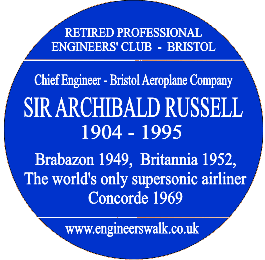Sir Archibald Russell started to work at Filton for the Bristol Aeroplane Company as
an assistant stress calculator in 1925 in the era of biplanes and retired as
Chairman, Filton Division, British Aircraft Corporation in 1969 in the era of the
supersonic airliner.
Russell was raised in the Forest of Dean and attended the school where his father was
headmaster. When he was fifteen the family moved to Bristol and his education
continued at Fairfield Grammar School, and then the Engineering faculty of Bristol
University where he gained a BSc in automotive engineering. His first job was
maintaining buses for the Bristol Tramways and Carriage Company (one of Sir George
White's companies).
Another of Sir George White's companies was The Bristol Aeroplane Company founded in
1910. Bristol made their name with the
Bristol Fighter biplane making over
5,500 during the Great War. They were making the last of another 600 when Russell
joined the company. He met Miss Lorna Mansfield, a secretary at the company, and they
were happily married for over 50 years.
Biplanes to Monoplanes 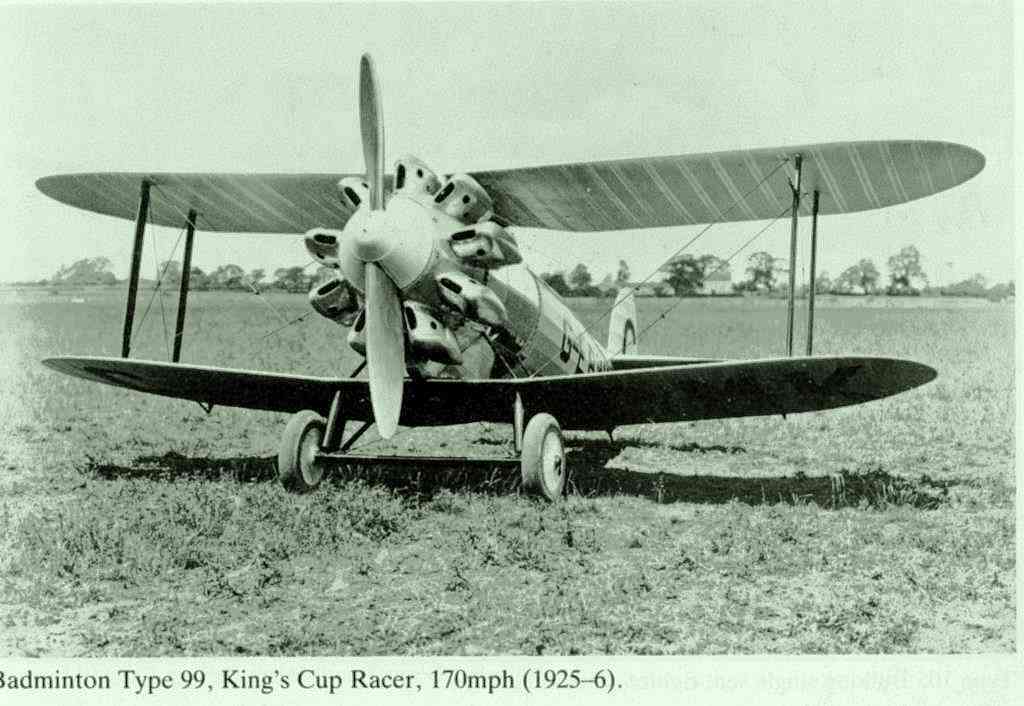
The years following the Great War were lean times for warplane manufacturers. Of 56
distinct Bristol designs only 18 reached flying prototypes and only 2 entered
production. One unsuccessful plane was the
Badminton, for which Russell did
the wing stress calculations, and specially designed for the 1926 King's Cup air
race, He was gravely concerned when the plane crashed a month before the race killing
the pilot. It turned out that the uprated engine had seized solid.
The
Bagshot of 1925 was an attempt at a monoplane fighter but it did not
perform well. Russell was sent up with the test pilot and he observed quite alarming
twisting of the wings.
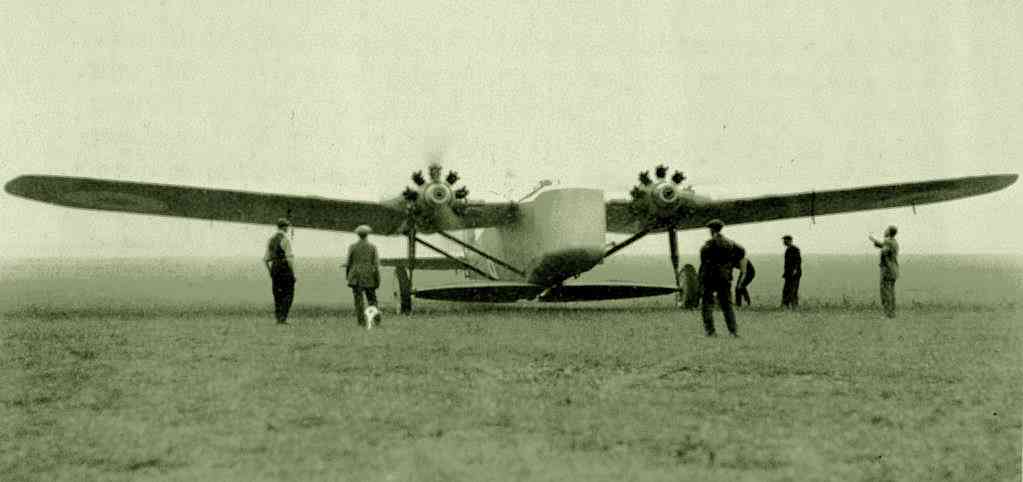
(The two wings of biplanes could be strutted and stayed to form a rigid 'box'
with high torsional stiffness) After inconclusive consultations with various
academics Russell realised that the bending and torsional stresses could be
calculated independently. He was later granted a patent on a single spar wing design
using these principles.
There was to be another successful biplane fighter from Bristol in the
Bulldog (1928).

Russell did the stress calculations for the wings and was an interested
observer of the loading tests that proved the validity of the calculations. A near
complete plane was suspended upside down and the wings were progressively loaded with
1600 bags of lead shot each weighing 16 lbs. In total 440
Bulldogs were
built including exports to many countries including Japan.
In the early 1930s a new sheet material became available. This was Alclad, a sandwich
of thin layers of aluminium (for corrosion resistance) over a layer of duralumin (for
strength). Covering a wing frame with this material gave a smooth surface and also
increased the torsional stiffness.
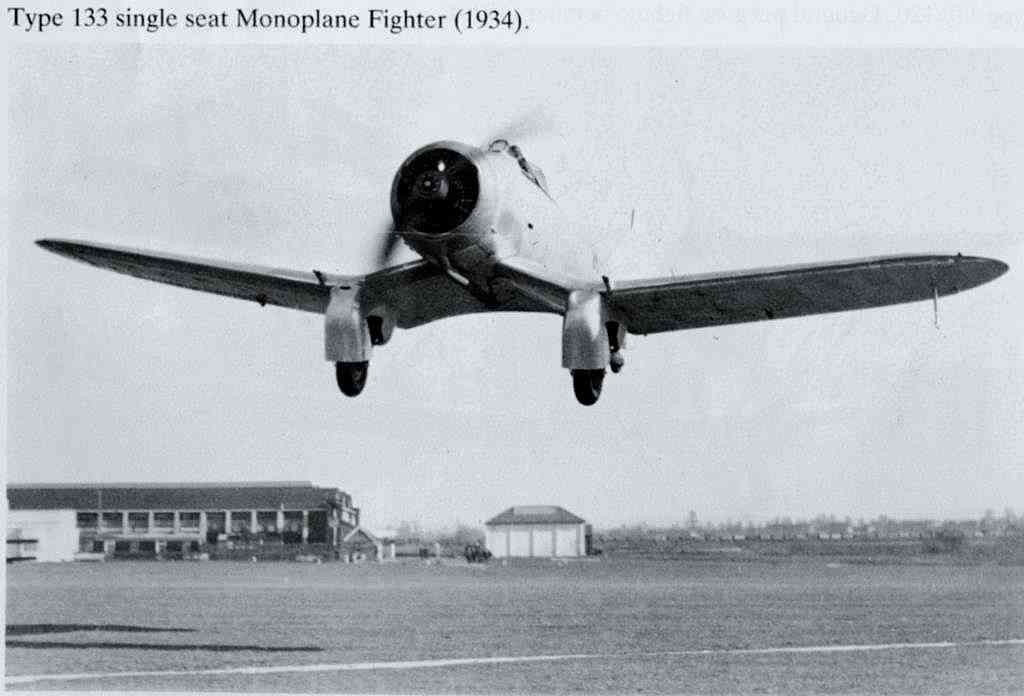
Now the company built the handsome Type 133 monoplane fighter of 1934. This plane
could fly at 250 mph and was 25 mph faster than any serving fighter or prototype
around. With all tests satisfactorily completed the plane looked like a winner, but
the day before official trials it was destroyed in a bizarre accident due to pilot
error. Contracts were placed for its slow rival the Gloster
Gladiator -
another biplane. The future looked bleak for Bristol.
Planes for World War II
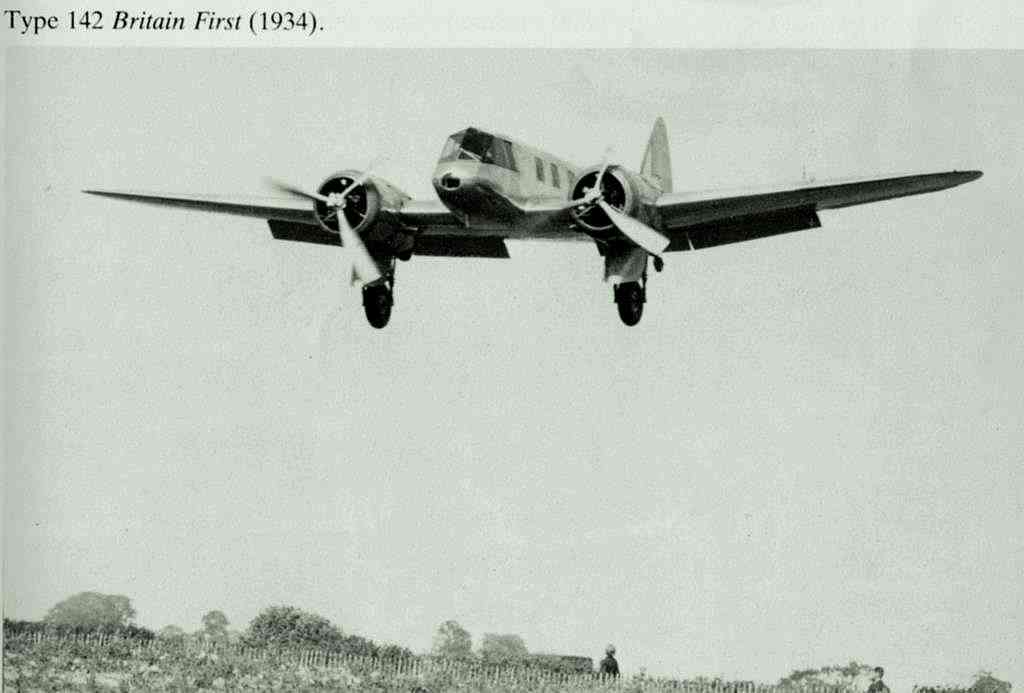
Lord
Rothermere ordered an aeroplane with the highest possible speed, a crew of two, and
cabin space for six passengers. Earlier plans for a small airliner were dusted off,
and soon Lord Rothermere had a twin engine monoplane Type 142 (1934) that could fly
at more than 300 mph. He named it
Britain First and used his newspapers to
boast that his new plane could fly 50 mph faster than the very latest RAF
fighters.
With a minimum of effort and a great deal of foresight the Type 142 was transformed
into a bomber the Type 142m
Blenheim (1936). The wings were raised from the
low position to mid fuselage to make room for a bomb cell with 1000 lb bomb capacity.
The Air Ministry placed orders for 718. Russell was made head of the Technical Office
responsible for stressing, structures development and tests, aerodynamics and weight
estimation. Derivatives from the
Blenheim using higher wing loadings,
increased engine power, higher payloads, gun turrets, radar etc. included,
- Bolingbroke (1937) - Coastal reconnaissance for the Royal Canadian Air
Force
- Beaufort (1938) - Tactical reconnaissance and torpedo carrier
- Beaufighter (1939) - Multi-role fighter/bomber
- Buckingham (1940) - Bomber
- Brigand (1944) - Torpedo carrier
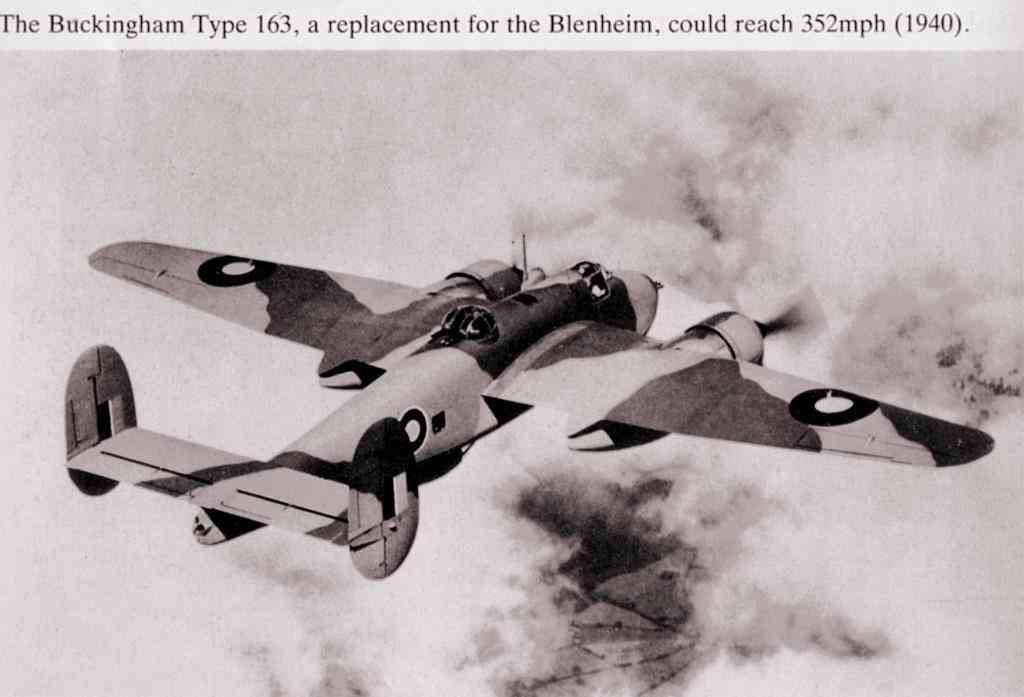 Blenheims
Blenheims were made in Canada,
Beauforts in Australia, and
large numbers of
Beaufighters were rolled out at Bristol and various shadow
factories. The
Buckingham was the fastest fully armed day bomber (330mph) of
its time, but when the Americans entered the war they took over day bombing, and
Buckingham production tailed off. In the midst of hostilities Bristol was
left without any new design work.
The best that came the company's way was a Design Study Contract for a bomber capable
of carrying an 80,000 lb. bomb load to Berlin at as high a cruising speed as
possible. For ten years the company had been designing medium sized twin-engine
monoplanes. Russell learnt all he could about streamlining and aerodynamics, so that
drag could be minimised in the big bomber. To provide sufficient power eight 2,500 HP
Centaurus engines were required. Arranged in pairs driving contra-rotating propellers
they could all be housed within a wing, with a span of 230 feet and area of 5,000
square feet, again minimising surface drag. Russell became Chief Designer and soon
the opportunity came to redesign the bomber as an airliner.
Post War Planes
The Brabazon
The Government had set up a committee under the chairmanship of Lord Brabazon to
determine post war policy for civil airliners.
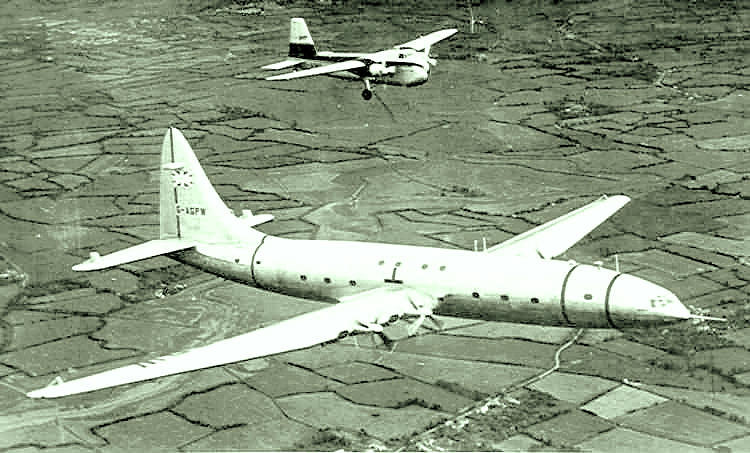
In February 1944 a
contract was placed with Bristol for detailed design of a luxury airliner for British
Overseas Airways Corporation (BOAC). Russell was appointed Chief Engineer and assumed
full responsibility for the
Brabazon. Original development work was required
on vibration testing, ac electrics, hydraulically powered flying controls etc. The
prototype, with Centaurus engines, flew in 1949
Unfortunately another new technology was overtaking the project - jet engines. De
Havilands were developing the
Comet with pure turbine engines, and Vickers
were developing the
Viscount with turbo prop engines. BOAC wanted Bristol
Proteus turbo prop engines in the next prototype
Brabazon.. By 1950 it was
obvious that the Proteus was not sufficiently developed to do the job and the
Brabazon project faded into history.
There were other more successful ventures at this time. The Directors instructed
Russell to produce a modest 'aerial truck' and the result was the twin-engine high
wing
Bristol Freighter that first flew in December 1945. The plane and its
passenger version Wayfarer sold in reasonable numbers to small operators all over the
world. They are well remembered for their car ferry operations.
As Chief Engineer Russell was also responsible for a recently acquired helicopter
company, that manufactured single and twin rotor machines, and for another
engineering group within the company that manufactured guided missiles, with ram jet
engines. The Bristol Ferranti Bloodhound was used by the Royal Navy, the RAF and was
also adopted in Sweden and Australia.
The Britannia
In 1947 Bristol won a design competition for 'An airliner to required to carry thirty
six passengers on routes to South Africa, Australia and the Far East.' The number of
passengers (36) had been set by the capacity of the standard BOAC airport bus!
Russell redesigned the plane for sixty eight passengers. Two years on BOAC wanted
Proteus turbo prop engines in this plane as well. The wing area and span of the
Britannia was increased, for greater altitude and speed and seating was
raised to 96 without altering the fuselage.
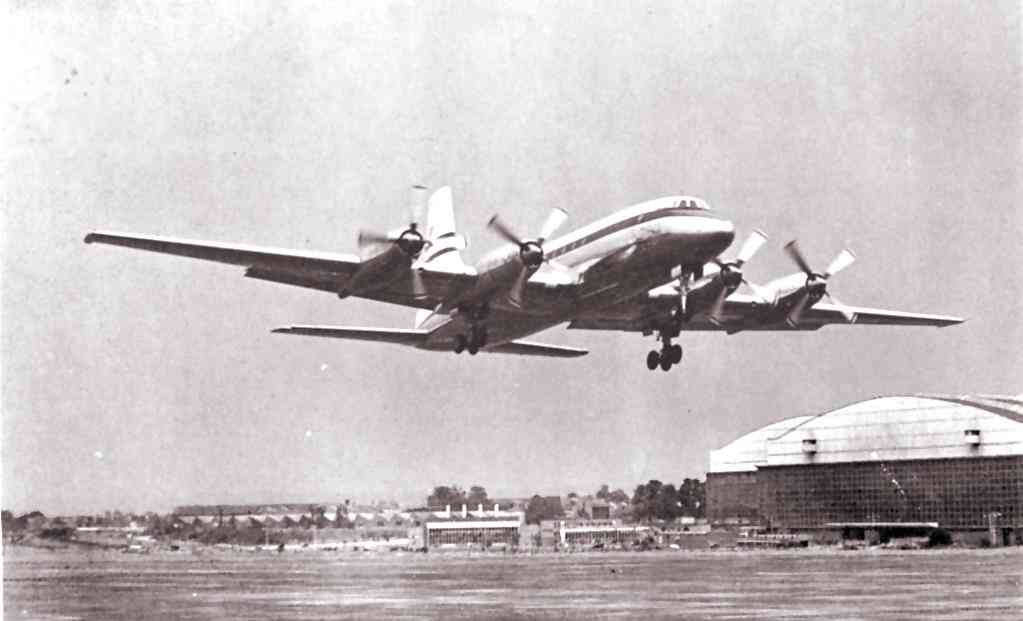
The
first prototype flew in August 1952 using the substandard Proteus engines. Little
more was achieved until December 1953 when the second prototype flew with the much
improved Proteus III engines designed by Stanley Hooker. Unfortunately an engine
exploded on a demonstration flight in February 1954 and with fire risk in mind, the
pilot ditched the plane in the mud of the Severn. The fault was failure of the
reduction gearing of the engine, and the solution was to change from straight to
helical toothed gears.
Worse was to follow for the
Britannia project, and for the British aircraft
industry in general. The De Haviland
Comet was the first jet engine airliner
in the world but it was grounded after three crashes in quick succession, the last in
April 1954, all due to metal fatigue. A water tank fatigue test became mandatory for
all British airliners and the
Britannia was probably the most thoroughly
tested plane ever at the time. There was further delay when icing problems in the
engines nacelles were encountered in of all places the Tropics! A solution to BOAC's
satisfaction took another year.
Britannia finally entered service in 1957 - 3 years late. It was a fine
aeroplane, but bigger pure jet airliners were now just around the corner and the
plane became a stopgap for major airlines. Ninety Britannias were built in Bristol
including twenty for RAF Transport Command and some exports. A long range version of
the plane could carry 96 passengers, non stop from London to New York, fulfilling the
dream of the original
Brabazon. Another 87 variants of the plane were built
under licence in Canada for military and civil use.
Last years of Bristol Aeroplane Company
The
Brabazon and
Britannia stories illustrate a weakness of the
civil aviation industry in the United Kingdom in the post war years. Russell pointed
out that the National carriers BOAC and BEA 'had unwisely been granted the privilege
of bespoke tailoring their aircraft requirements, heedless of international sales
potential.' None of the manufacturers were reaping the benefits of long production
runs.
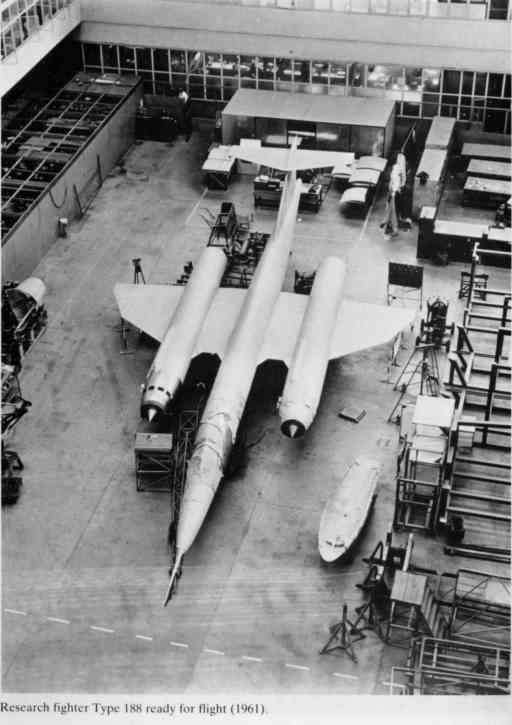
After
the very successful Vickers
Viscount, BEA ordered a new turboprop plane the
Vanguard at very high cost, instead of a modest modification of
Britannia. Bristol had a three engine design (Type 200), the very first of
this configuration, but BEA bought De Haviland
Tridents, whilst the rest of
the world bought
Boeing 727. The
Boeing 707 was sold world wide,
but BOAC bought the
Vickers VC10. Bristol was losing out all round and
reorganisation of the industry was inevitable.
Russell took the opportunity in these lean times to learn about supersonic flight.
Bristol built two stainless steel research planes (Type188) designed for Mach 3, but
limited in trials to Mach 1.8 by underpowered engines. From the Royal Aircraft
Establishment at Farnborough, Russell also learned of a 'breathtaking novelty' for
supersonic flight - a narrow delta wing with a sharp leading edge. With immediate
separation at the nose, the airflow rolls up into a strong vortex over the wing.
Contrary to all existing streamline theory there was no aerodynamic penalty with this
vortex. The configuration also reduced stall to such an extent that landing flaps
were un-necessary.
American manufacturers were considering Mach 3 planes but Bristol settled on Mach
2.2. This was the maximum speed for which the surface temperature rise would not be
excessive using the latest aluminium alloys. The Bristol design study of 1959 and the
revision (Type 223) of 1960 for a transatlantic airliner had a narrow delta wing, a
variable geometry cockpit and engines in nacelles under the wings.
Concorde
as built looks remarkably like these studies. But reorganisation came first.
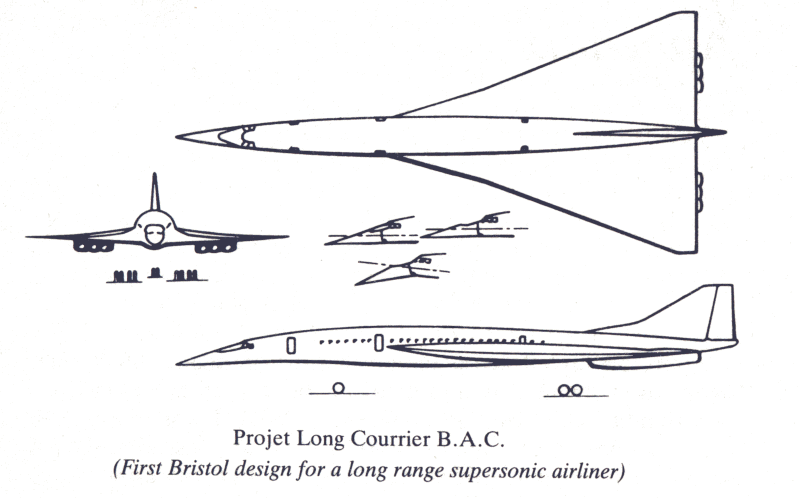
In 1958 there were still 27 aircraft companies and 7 engine manufacturers in the
United Kingdom. The Minister of Aviation forced the industry to organise itself into
two aircraft groups. In 1960 Bristol aircraft merged with Vickers Armstrong, English
Electric and Hunting as the British Aircraft Corporation. Russell was appointed
Managing Director, Filton. The other group was Hawker Siddeley.
Concorde
The strongest player in French aviation was Sud Aviation based in Toulouse after
their successful
Caravelle jet airliners. Sud had been doing design studies
for a smaller Mach 2 transcontinental airliner, assuming that America would produce a
Mach 3 intercontinental airliner.
There was considerable politicking, not least Prime Minister Heath's desire to take
the United Kingdom into the Common Market against French opposition. In 1962 the two
Governments signed an agreement that British Aircraft Corporation, Sud Avation,
Bristol Siddeley Engines and SNECMA the French engine company, should cooperate to
design a single supersonic aircraft in two versions one long range and one short
range. Bristol Siddeley already had a proven engine in the Olympus, and took the lead
in engines. To balance this Sud Aviation took the lead in the aircraft. M. Pierre
Satre, the acclaimed designer of the
Caravelle, was appointed Technical
Director and Russell was appointed Deputy.
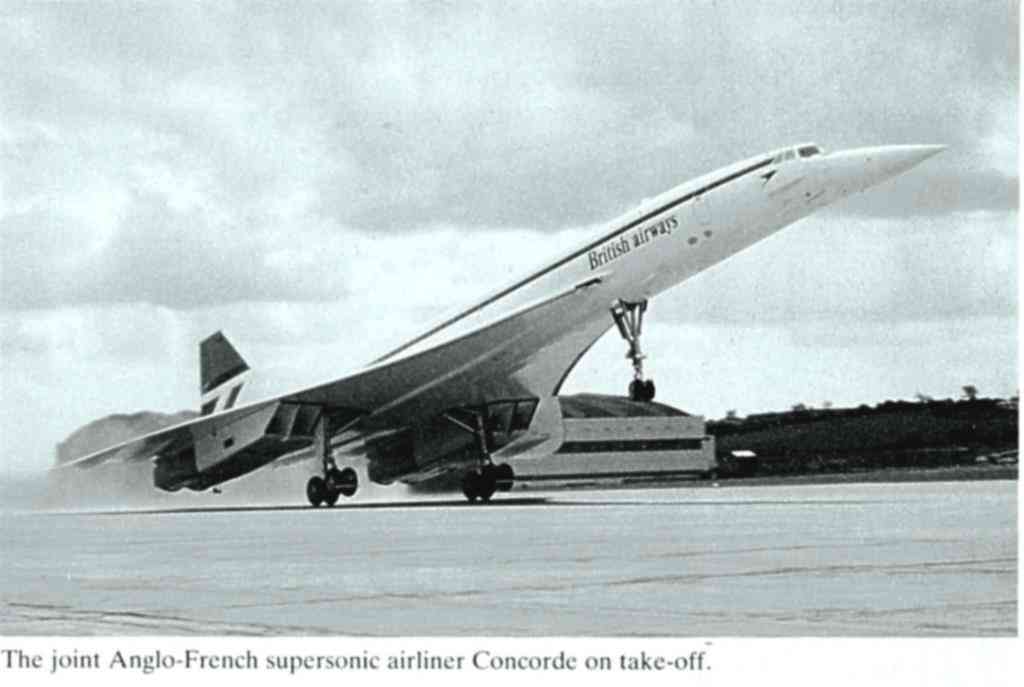
Somehow
the project survived political problems, national pride and jealousies, cost rises,
environmental objections, duplicate production lines and technical problems. It was
the French that proposed dropping the short range version. The first metal was cut in
1965, and the first prototype flew in March 1969.
Concorde was a technical
triumph but was not a commercial success. The only buyers were British Airways and
Air France.
Russell was appointed Chairman, Filton Division of British Aircraft Corporation in
1968 and retired in 1969.
Postscript
Airbus Industrie was a product of commercial interests between Hawker Siddeley and
German and French companies. Without government support Hawker took only a 20 % share
of Airbus. In 1977 the government nationalised the aircraft industry merging British
Aircraft Corporation and Hawker Siddeley, and the new British Aerospace inherited
Hawker's stake in Airbus.
The very core of Sir Archibald Russell's many talents was designing wings and
calculating stresses. Perhaps his greatest legacy is that the wings for all of the
Airbuses have been designed at Filton in Bristol, and Airbus Industrie is now the
largest manufacturer of airliners in the world.
John Coneybeare August 2005
